Let's be clear: Captivity in zoos is not conservation for elephants.
2017 was a landmark year of progress for captive elephants in North America. The infamous Ringling Bros. and Barnum & Bailey Circus called it quits, Illinois and New York State passed prohibitions on the use of elephants for entertainment, and New York City banned the use of all wild animals in circuses. In the U.S. and Canada, more than 100 jurisdictions now have partial or full bans on wild animals used in performances. At least 44 zoos around the world have closed their elephant exhibitions, including 29 in the U.S. And now, the first ever lawsuit on behalf of captive elephants has been filed, arguing for their legal personhood. Globally, over 40 countries have legislated against the use of wild animals in circuses and similar forms of entertainment.
Perceptions about elephants, and the times, are truly changing. But while public awareness of the cruelty of exhibiting elephants for entertainment is increasing, elephants in zoos are suffering under the radar. Most zoos are trying to cling to respectability by misleading the public with conservation lies. Zoo tickets fund a conservation con.
Now in its 14th year, In Defense of Animals produces the 10 Worst Zoos for Elephants in North America List to expose how elephants suffer silently in captivity, even when confined in pricey exhibits. Elephants live longer in the wild than in captivity, even when droughts and poaching are taken into account*. Elephants do not reproduce well in captivity either; they die faster than they can be born. This losing formula sends zoos to the wild to steal juveniles which traumatizes and kills individuals, destroys families and cultures, and fractures multi-generational elephant lineages and their ecosystems. In 2017, the violent nature of elephant capture for zoos was finally revealed to the public with brutal footage of babies ripped from their family herd in Zimbabwe and beaten before being sent to zoos in China. U.S. zoos are also involved in this sordid business, with no fewer than 18 wild elephants kidnapped from the wild in Swaziland to eventually stock three U.S. zoos in 2015.
This year's list features zoos with some of the world's most expensive elephant exhibits and exposes how inadequate they are in meeting the complex needs of elephants at these glorified playgrounds for paying visitors and donors. Tragically, this list features several zoos that deprive elephants of their most essential psychological need: the presence of other elephants with whom they are compatible. Some of the loneliest elephants in the world can be found in North American zoos.
The zoological industry is trying to distort the public's definition of “elephant herds” by implying that captive elephant “collections” in North America can still be called herds. It is misleading and dangerous to fabricate elephant societies with groups of mostly unrelated individuals who are deprived of their real families, choices, cultures, and ecosystems.
Hundreds of millions of dollars are being spent on elephant zoo exhibits in the U.S., yet these funds are desperately needed to avert the extinction of elephants in the wild. Where they still exist, elephants are facing severe threats from ivory poaching, human encroachment, and collections by zoos. The wild is the only place where true conservation of elephant families, their habitats, and their rich cultures can take place. We invite zoos that are sincerely concerned about elephant conservation to close their elephant exhibits and put their money where elephants need it most… in the wild.
How Does In Defense of Animals Determine which Zoos Make the List?
While all zoos confining elephants for public display in the U.S. and Canada are considered, In Defense of Animals focuses on a number of factors to narrow down the list. We assess facilities in-person, through review of government and veterinary records, death reports, consultation with elephant scientists and other experts, and via image and data documentation. Priority is given to notable events occurring in the prior year, such as premature elephant deaths or overt violations of the Animal Welfare Act and egregious disregard for the social and medical needs of elephants. Other factors include health problems, unsuitable enclosures, cold climates, reckless breeding, unhealthy elephant behaviors, brutal management procedures, and inappropriate social challenges ranging from incompatibility between elephants to naturally social elephants being kept in crushing solitary confinement.
*Despite the provision of veterinary treatment, food and water, elephants in zoos are still not thriving. Michael Berens published a report in The Seattle Times on December 4, 2012 with its findings on an analysis of 390 elephant fatalities at accredited U.S. zoos for the previous 50 years. Of the 321 deaths in captivity for which records were available, half the elephants were dead by age 23, about a third of their expected life span of 65 to 70 years. It found that “most of the elephants died from injury or disease linked to conditions of their captivity, from chronic foot problems caused by standing on hard surfaces to musculoskeletal disorders from inactivity...” A 2008 study by Ros Clubb et al. in Science, entitled, Compromised Survivorship in Zoo Elephants, supports Berens' findings. For elephants, captivity kills.
2017 Ten Worst Zoos for Elephants in North America
1. Topeka Zoo, Topeka, Kansas
The Cruel Tip of a Larger Iceberg
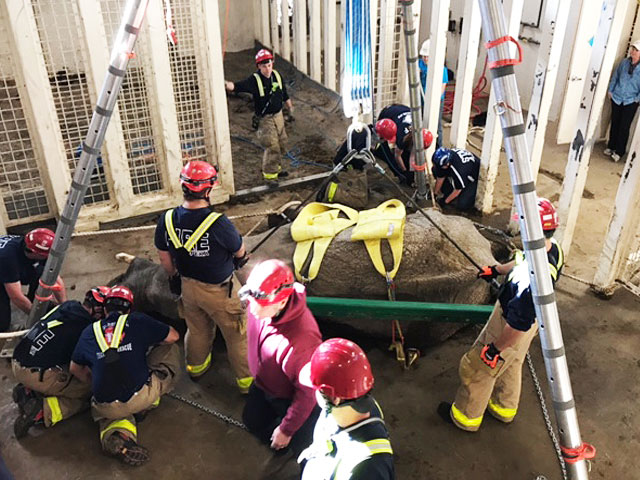
CREDIT: Topeka Zoo
Topeka Zoo in Kansas failed to adequately care for Shannon, a 35-year-old African elephant who died after reportedly spending ten brutal hours down on her side without any monitoring from zoo staff who had left for the night. This is particularly inexcusable since Shannon had been found down and unable to rise on her own just the day before when the zoo first had to call firefighters to help hoist her to her feet. It should be patently obvious that severely sick elephants must be watched closely around the clock. Instead the zoo chose not to keep someone on site to monitor Shannon's video feed, which they apparently could have done without even disturbing the elephant. Given the seriousness of this situation, the zoo's actions were nothing short of gross neglect and blatantly inadequate care.
Also disturbing, is that medical records indicate that Shannon was suffering for weeks, showing signs of pain, tremors, and weakness. Regardless of the cause of death, proper observation and intervention would have likely minimized Shannon's suffering, and could have possibly even prevented her death. After the fact, the Topeka Zoo reported that it bought a new video monitoring system. This is far too little – far too late.
Shannon's death is indicative of the longtime problems that continue to plague this zoo and its animals. This zoo has been cited numerous times for violations of Federal Animal Welfare regulations that include animal deaths, injuries, and lack of proper veterinary care. In 2013, the zoo paid a $45,000 civil penalty to settle charges brought against it by the USDA for at least 51 willful violations of the Animal Welfare Act (12 of the violations took place after Brendan Wiley became Zoo Director). The charges included failure to provide adequate veterinary care for elephants Tembo and Sunda, including problems with their skin, feet, and nutrition.
The elephants remaining at this zoo are at risk. Asian elephant Sunda has a history of chronic foot disease caused by lack of movement and standing on hard surfaces throughout many years. Topeka's cold winters only exacerbate any health problems, as the elephants are forced to remain indoors - with minimal exercise - for excessively long periods. Cora, an Asian elephant, who came to the zoo in 2016 with Shannon, is particularly at risk because of the health issues associated with performing unnatural circus tricks, which she did for many years before coming to the zoo.
Remaining elephants Cora, Tembo, and Sunda are no doubt aching for the warm weather and soft surfaces of a sanctuary. We call on the Topeka Zoo to avert further tragedy and release these elephants to an accredited sanctuary uniquely equipped and skilled at providing for the needs of elephants. Short of that, we call upon the USDA to confiscate these elephants. Shannon's death is only symptomatic - and the tip of the iceberg - of the zoo's continued and general lack of capability to care adequately for elephants.
Not surprisingly, this is the 6th time Topeka Zoo has appeared on our list.
2. Pittsburgh Zoo and International Conservation Center, Pittsburgh, Pennsylvania
Profit Over Elephant Welfare
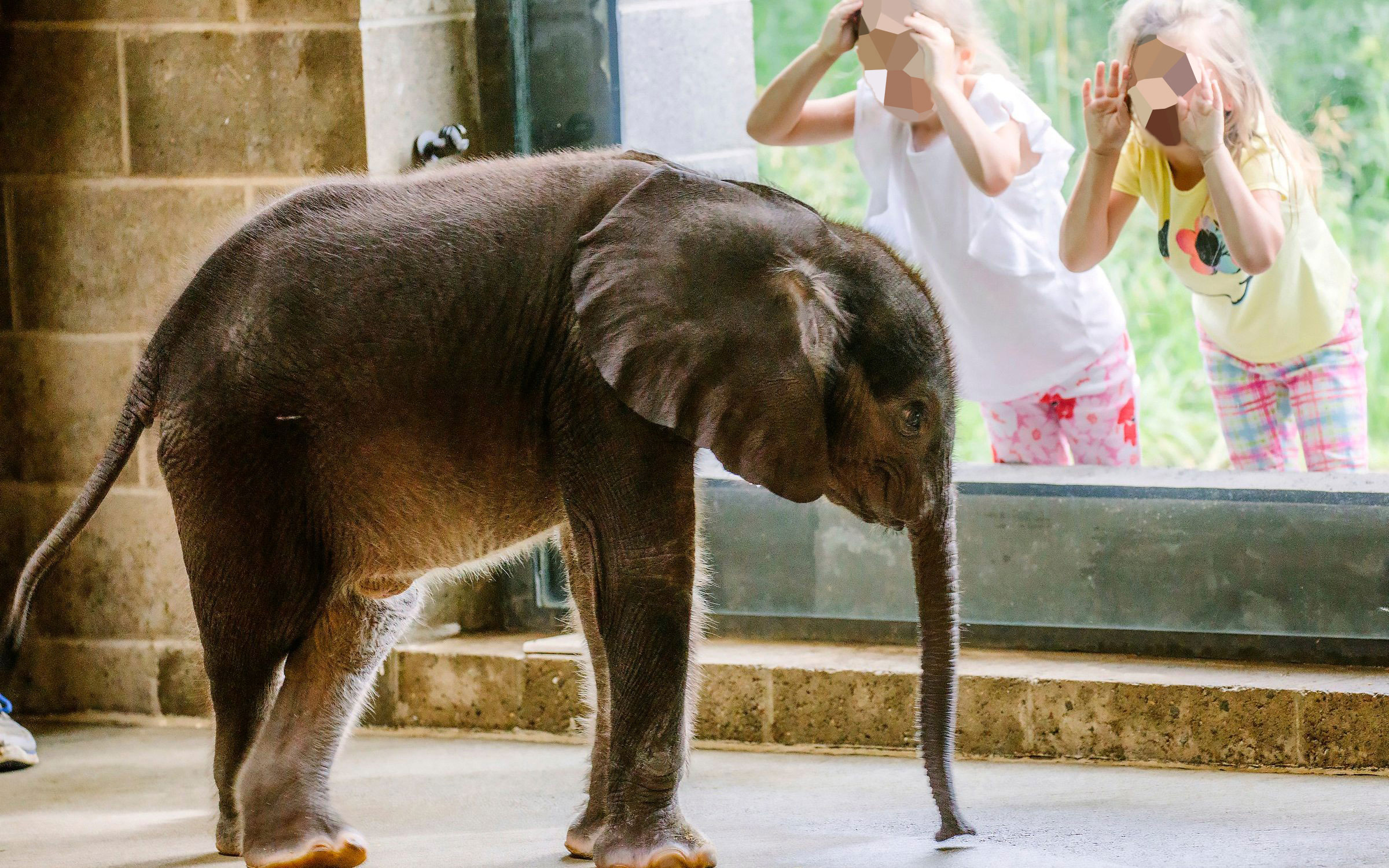
CREDIT: Andrew Rush, AP
In 2017, the Pittsburgh Zoo's International Conservation Center (ICC) saw its first elephant birth in ten years. But the small female calf was born prematurely, then reportedly rejected by her mother, who was also unable to produce enough milk for the baby. Normally, zoos would keep such a calf on-site and near the mother hoping to help the two bond, while hand-rearing the calf. Instead, the unnamed calf was transported from the ICC to the Pittsburgh Zoo where she was exhibited in a barren room behind glass until her tragic and early demise at less than three months of age.
Whether separating the baby and her mother was the right thing to do is debatable. What is not debatable is the zoo's unconscionable display of the lone, vulnerable baby to attract paying customers, while her very survival was so tenuous that the zoo did not even bother to give her a name. One study of U.S. zoos revealed the captive infant mortality rate is a staggering 40 percent - nearly triple that of elephant babies in the wild.
The Pittsburgh Zoo has a history of ignoring or compromising the welfare of its elephants. The zoo was cited by the USDA in 2015 for terrorizing elephants with dogs who frightened and even bit the elephants. Pittsburgh Zoo also insisted on maintaining the archaic practice of using bullhooks (devices resembling fireplace pokers with sharpened steel tips) to control elephants through fear and pain, instead of complying with a new policy implemented by the Association of Zoos and Aquariums (AZA). This modern handling practice is a safer and more humane management method that provides a protective barrier between keepers and elephants, and relies on positive reinforcement. With this decision, the zoo withdrew from the AZA and continued using bullhooks. But in 2017, the city of Pittsburgh joined other cities in voting to ban the use of cruel bullhooks. The Pittsburgh Zoo will likely be directly impacted by the City Council's move to protect elephants, as they will hopefully be forced, by law, to stop torturing their elephants with these barbaric devices.
The lonely life and death of the baby elephant was horrific. In Defense of Animals also sympathizes with the calf's mother, Seeni, who was imported from Africa for the purpose of breeding elephants for display in zoos. As Seeni had been orphaned herself, she did not have a chance to learn vital maternal skills. But even though she was known to have rejected her first calf while in captivity in Botswana, the Pittsburgh Zoo was determined to get a calf for display, no matter the consequences. In the wild, mothers are not known to reject or kill their calves. This happens in captivity where elephants are deprived of the social support naturally provided by mothers, aunts, and grandmothers to help ensure a calf's survival.
Shame on the Pittsburgh Zoo for exploiting Seeni, who suffered her own traumas in Africa and again when imported to a zoo, and for exploiting her unnamed calf for the short time she had on this Earth.
3. Omaha's Henry Doorly Zoo and Aquarium, Omaha, Nebraska
Bottom-Line Bull
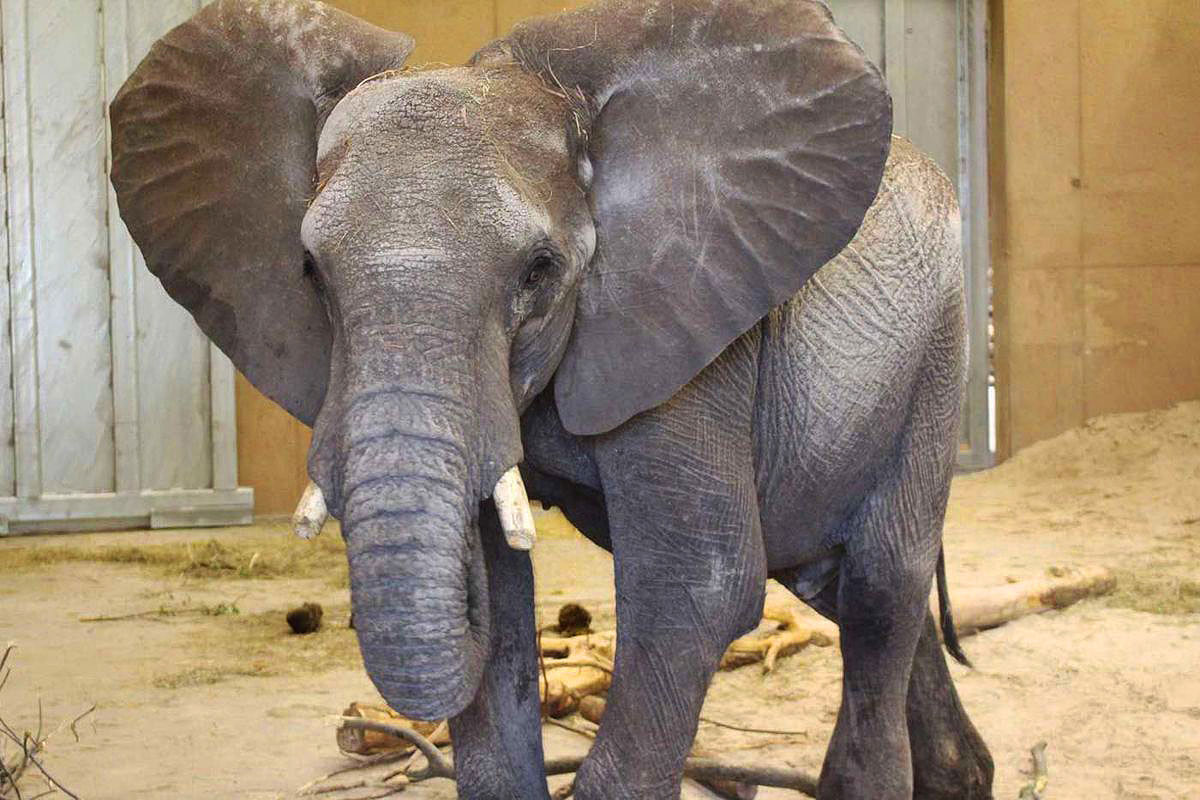
CREDIT: Warren BH, News Service
In 2015, the Henry Doorly Zoo was one of three U.S. zoos that ignited a firestorm of condemnation from conservationists around the world when the zoos controversially imported 17 wild-caught elephants from Swaziland. This reprehensible kidnapping earned these three zoos the unenviable position of shared placement as IDA's #1 Worst Zoo for Elephants List in 2015 for executing a massive conservation con masked as a rescue mission. Among the six elephants transferred to Omaha was Warren, whose young life was cut short in 2017 at just nine years old.
Warren died while under anesthesia for a procedure to repair a cracked tusk. According to two of the world's most eminent elephant experts, Drs. Cynthia Moss and Joyce Poole, cracked tusks such as Warren's are unseen in the wild in such young elephants. Dr. Poole attributed his tusk condition to the unnatural surfaces of his enclosure, where elephants' tusks can become prematurely worn or cracked from banging or rubbing against hard surfaces. She stated, "Warren's captivity is likely what prompted his tusk problem in the first place."
The zoo staff tried to save Warren's life, but part of Omaha Zoo's general curator's caustic response to this tragedy was, "Now, basically, we don't have a backup male." The zoo's remaining lone bull elephant is Louie, a 14-year-old African elephant from the Toledo Zoo who was transferred to Omaha three months before Warren died. Like Warren, his purpose is to breed with the Swaziland females and produce more calves for zoos. In Defense of Animals highlighted Louie's sad and lonely future on our 2009 Worst Zoos for Elephants list.
According to the zoo, if its breeding plan for Louie is successful, every odd-numbered male and female baby fathered by Louie will "belong" to the Omaha Zoo, and every even-numbered male and female baby will "belong" to the Toledo Zoo, coldly disregarding and severing vital family and social bonds.
Elephants in captivity are treated as mere commodities to be traded for maximum profit, and the bulls are simply the means to the bottom line: money. Conservation for elephants cannot be achieved in captivity, nor can it be achieved by stealing elephants from the wild to prop up dying and dysfunctional captive zoo populations.
RIP Warren. We profoundly apologize for your stolen, short life.
4. Louisville Zoo, Louisville, Kentucky
Chained and Violated at the Zoo
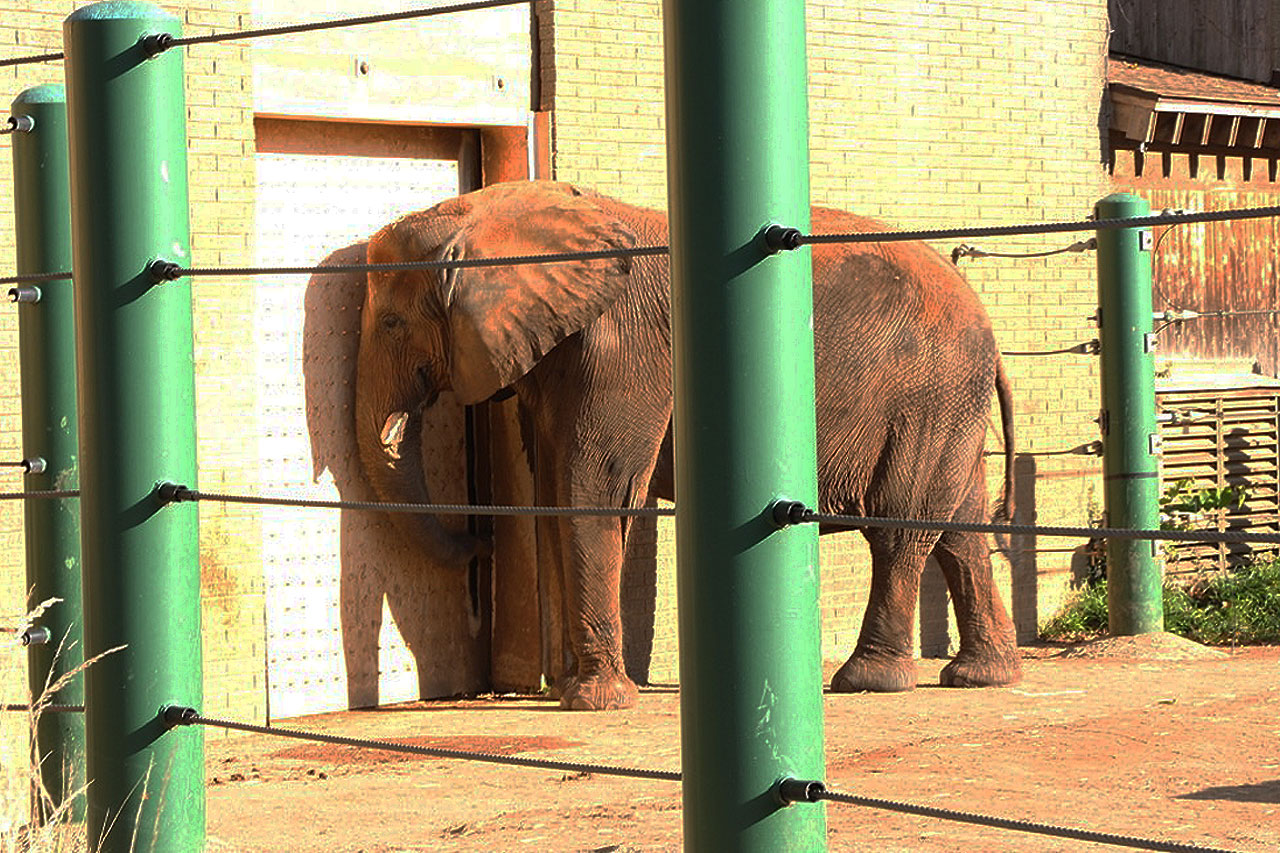
CREDIT: Adam Kennedy, In Defense of Animals
Mikki is a female African elephant at the Louisville Zoo. Shockingly, the zoo immobilizes her with chains and ropes, not for medical benefit, but for attempts to impregnate her and restock the zoo's elephant exhibit. Since losing her three-year-old son Scotty to colic in 2010, the zoo has repeatedly botched attempts to artificially impregnate Mikki. Our review of some of her medical records revealed many forceful, insensitive, clumsy, and always invasive attempts at this procedure. Mikki's situation is just one example of what many female elephants are forced to endure to restock zoos around the world, under the con of "conservation."
These records note, among other unnecessary violations, that from February 26, 2014 through January 30, 2016, there were nine attempts at artificial insemination, plus three practice sessions. Each time, Mikki was prepped and positioned for the procedure with one front leg chained and rope tethering both rear legs so that she stood immobilized in the stall with her rear legs slightly widened. The records are filled with the zoo's ham-fisted tries at the invasive procedure. For example "... staff had a 'practice' artificial insemination session with Mikki in restricted contact … This session was very frustrating as the endoscope kept turning back on itself and we were never even able to visualize the vagina, let alone get to the cervix.... Try again tomorrow." On other dates, she underwent this procedure with the staff fully aware that the semen to be injected into her was "of poor quality and unlikely to result in a pregnancy."
Zoos resort to using artificial insemination because elephants breed poorly in captivity. This is a procedure that is forced on the elephant; she has no choice in the matter. The zoo's brutal attempts to impregnate Mikki need to stop.
Mikki should have the opportunity to live safe from harm in a more natural and healthy environment at an accredited sanctuary. A sanctuary would honor the relationship that has developed between Mikki (an African elephant) and Punch (an Asian elephant), while also giving them the opportunity to be with elephants of their own species. Retirement to a sanctuary would offer both elephants infinitely more choices than they have now – one of which is not to be subjected to endless violations that are not in their own interests.
5. Oregon Zoo, Portland, Oregon
Zoothanasia: Murder Masquerading as Mercy
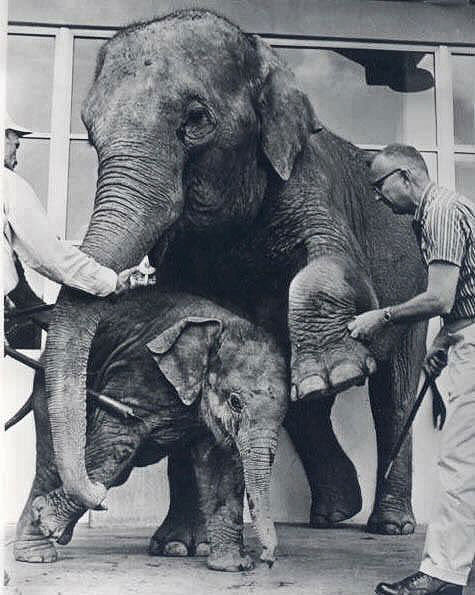
CREDIT: Oregon Historical Society Research Library
Asian elephant, Packy, was born to great fanfare at the Oregon Zoo in 1962 and became a local sensation. Fifty-four years later, he was diagnosed with active and drug-resistant tuberculosis. In 2017, he was killed in a shocking act of "zoothanasia," the controversial practice of killing animals who are considered surplus to zoo breeding programs. This term certainly applies to Packy, who was no longer of use to the zoo, and required intense care and expense.
Though Packy's illness was deemed incurable, it was reported that he showed no signs of suffering from the disease itself. One of his keepers described him as "showing no signs of pain or discomfort" and "active, playful and engaged with keeper staff every day." The Oregon Zoo's own Facebook page repeatedly corroborated the absence of signs of illness, and in December 2016 a zoo official told the Portland Tribune, "Day to day he doesn't appear to be suffering…" Yet on February 9, 2017, the Oregon Zoo killed Packy.
The truth is that zoos have limited room for animals, and those who are old or ill are considered to be taking up space that could be given to younger, reproductively active animals who can produce more animals for show. This is exemplified by a comment reportedly made by a member of the Oregon Zoo staff in a meeting: "How much is a 54-year-old bull worth compared to a four-year-old reproductive calf?"
In Defense of Animals and Dr. Marc Bekoff, who coined the term "zoothanasia," have declared February 9th as "World Zoothanasia Day" in honor of Packy, and countless other unwanted animals who are treated like excess baggage and regularly killed by zoos.
Oregon Zoo brought Packy into the world, profited from him for decades, and then betrayed him. This is the eighth year the Oregon Zoo is on the Ten Worst Zoos for Elephants List. Right now, it seems the saddest of them all.
6. Myrtle Beach Safari, Myrtle Beach, South Carolina
Masters of Exploitation
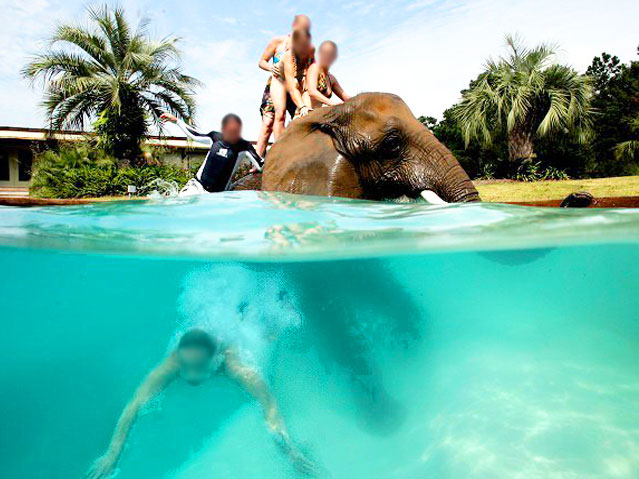
CREDIT: Myrtle Beach Safari
At this bizarre, self-described "safari," the public can book tours to see, touch, feed, or have a photo op with the African elephant known as Bubbles. This elephant has lived alone without the company of other elephants since her arrival here in 1984, after being bought by Bhagavan Kevin Antle, owner of Myrtle Beach Safari. In 2017, she was shown ridden by hordes of bikini-clad women and swim-suited men used as a "pool toy" on this facility's YouTube page. Her life consists of a menagerie of other animals and people, but no other elephants in sight.
Myrtle Beach Safari has amassed several USDA violations over the years. Examples include repeated failures to maintain adequate veterinary care for Bubbles and other animals; failure to provide wholesome, palatable food of sufficient quality and nutrient value free from contamination; failure to provide adequate fencing to protect the elephant from vandals, predators, or from running onto the highway; and failure to obtain adequate permits for the exhibition of Bubbles at non-licensed facilities. The owner is also a notorious exploiter of other species, with a despicable tiger breeding factory that supplies cubs for tourist photos.
Elephants are highly social animals who naturally live in large, complex social networks and develop relationships that last a lifetime. Bubbles should be retired to an accredited sanctuary where she can socialize with others of her own kind. Her 34 years of cruel exploitation must come to an end.
7. Two Tails Ranch, Williston, Florida
A Circus of an Elephant Zoo
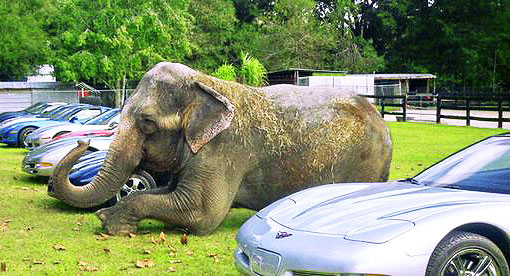
CREDIT: Two Tails Ranch Pinterest
Two Tails Ranch offers tours six days a week for the public to see its eight Asian elephants and menagerie of other captive animals. And when they're not on public display, Two Tails forces elephants to tour and perform in traveling circuses. This facility is pulling a circus trick, masquerading as a zoo, when in fact it is part of a family-owned traveling circus with a history of animal welfare citations and government actions against it, both in the U.S. and Canada. Canadian authorities recently refused entry of two of its elephants, Shell and Marie.
Two Tails' most notorious performance was when a visiting woman suffered very serious injuries after one of the elephants tried to pull her through a fence. Two Tails had already been warned that its fencing was inadequate. As a result, Two Tails was fined in 2014 by the USDA for failing to protect the public with a barrier.
Tuberculosis is a very common and risky disease in zoo elephants. Two Tails was cited by the USDA in 2011 for exposing two elephants to the disease by failing to take adequate quarantine provisions. Despite the risk to the public, Two Tails still offers elephant rides to paying customers and close contact that includes touching, sitting on elephants' legs, and hand-feeding, putting both the elephants and humans at risk from disease and injury.
At least two of Two Tails' elephants, ageing Marie and Shell, can't escape the annual grueling circus circuit that can last eight months a year. They are forced to travel from place to place with the likes of the Tarzan Zerbini Circus, TZ Productions, and the Royal Canadian Circus.
Travelling circuses are terrible for elephant health and psychological well being because they must endure the most unnatural of captive environments. Circuses force elephants to stand in transport trucks for long periods of time, perform in arenas surrounded by loud voices, applause, and other unnatural and stressful noises, and deprive them of virtually any vital natural experiences and freedom of choice.
Two Tails fails elephants. It is a zoo charade that supports the inhumane and increasingly obsolete circus trade.
8. St. Louis Zoo, St. Louis, Missouri
"Need to Breed" Comes at High Cost to Elephants
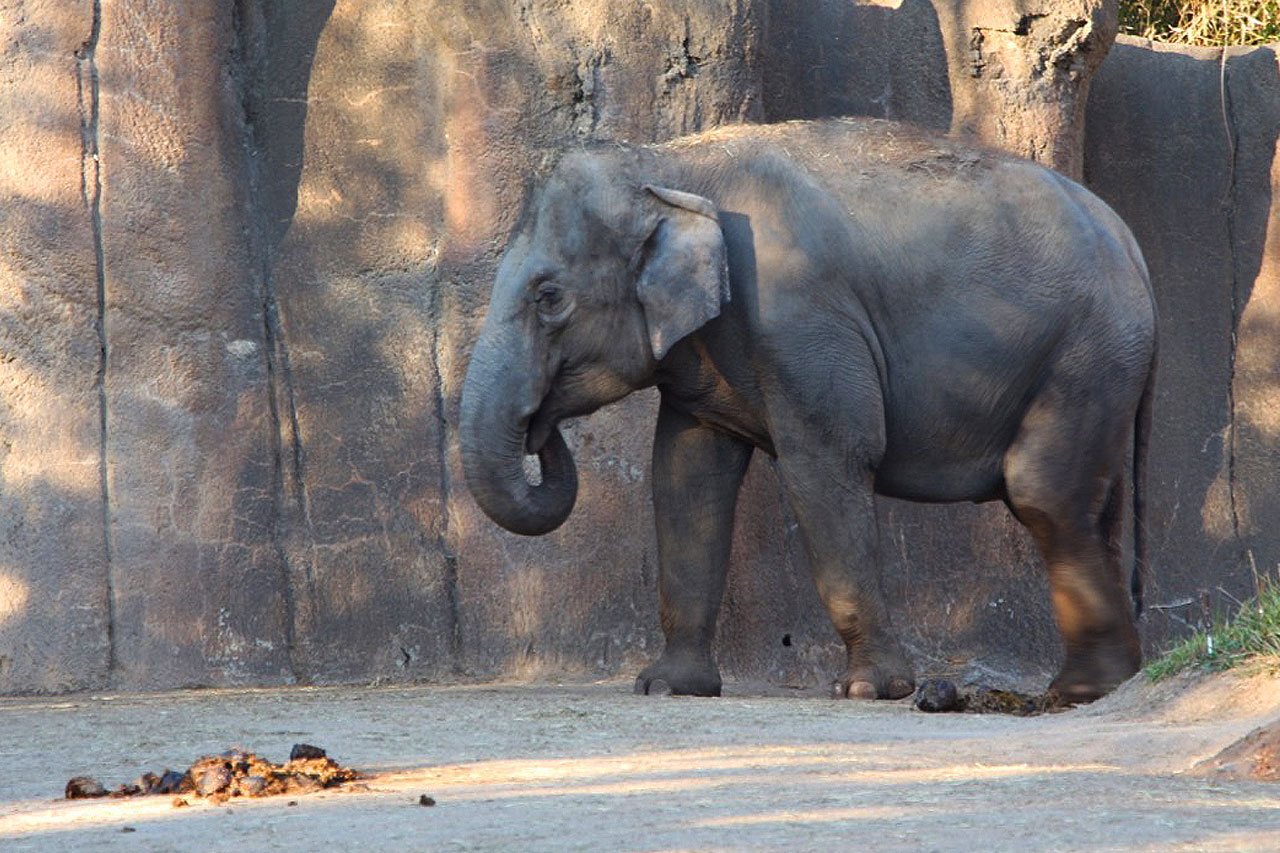
CREDIT: Adam Kennedy, In Defense of Animals
In 2017 yet another elephant at the St. Louis Zoo, Ellie, was diagnosed with tuberculosis (TB). Still, a headline on the Zoo's website reads, "The Need to Breed," suggesting that the zoo has continued its elephant breeding program, despite the presence of TB and endotheliotropic herpes virus (EEHV), reportedly in four of the ten Asian elephants held captive there. Any future offspring would likely face certain exposure to these debilitating and even fatal contagious diseases.
Ellie is not the first elephant at St. Louis to be diagnosed with TB. Before her, Donna was found to be suffering from the disease and received treatment. At the time, the zoo kept Donna off exhibit, but she was allowed to remain with the other elephants, presumably because all the females had already been exposed to TB through her. Back in 2000, Carolyn, a 32-year-old Asian elephant died at the zoo from a bacterial kidney infection and was later found to have TB.
Elephants carry the same strain of TB as humans, so it is transmissible to both humans and other elephants. TB in elephants is not well understood, making its detection and treatment challenging. Elephants typically do not show symptoms of TB; it is discovered through rigorous, regular testing that should be mandatory. Yet in 2015 the USDA issued a change, replacing mandatory testing with voluntary testing for TB in elephants, virtually ensuring that the disease will continue to ravage captive elephants. While the St. Louis Zoo opted to continue testing, this newly diagnosed case of TB shows that the problem is not going away and that the USDA needs to reinstate its guidelines for regular TB testing of elephants.
Recent media reports of a birthday celebration for one of the elephants, Raja, exemplifies that elephants do not belong in cold-climate zoos. The weather was so intolerably cold that even the zoo's own website stated Raja could not even go outside to "celebrate" his birthday. The paying visitors enjoyed the day, coming and going as they liked … while Raja's celebration was to be held prisoner - with even further restricted movement - in his tiny enclosure, encapsulated by a bitter winter.
Given the zoo is a hotbed for TB and the dreaded elephant herpesvirus, In Defense of Animals calls on the St. Louis Zoo to do the right thing and end its breeding program to ensure that no other elephants are exposed to these hideous diseases. These elephants belong in a reasonably temperate sanctuary where they can lead reasonably healthy lives.
9. Natural Bridge Zoo, Rockbridge County, Virginia
Unnatural Hellhole Still on Worst Zoos List
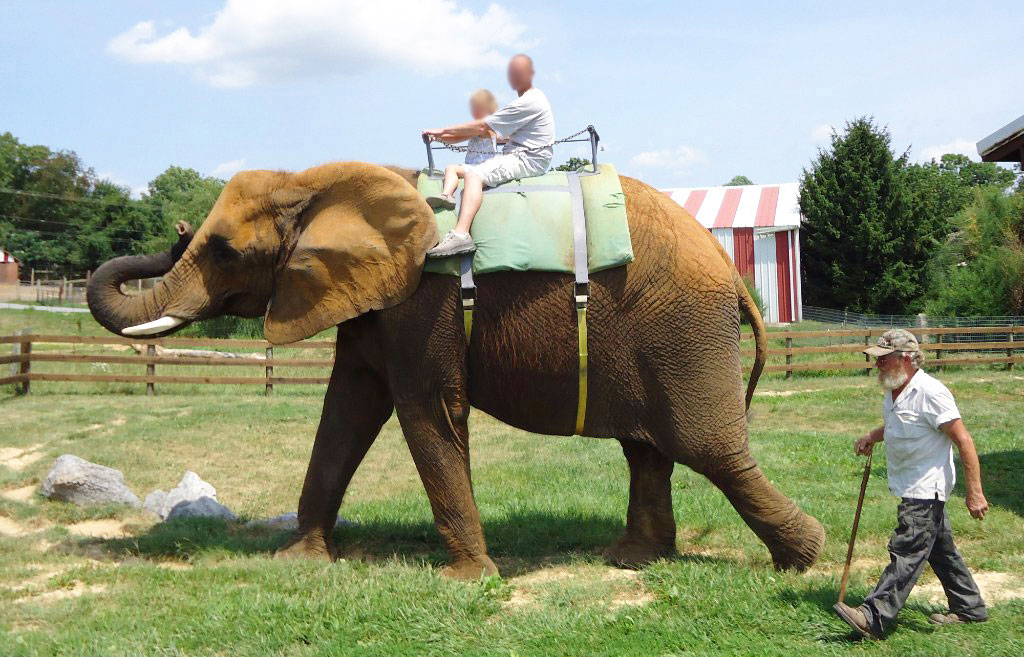
CREDIT: Tripadvisor
At the Natural Bridge Zoo, you can still find a lone African elephant, Asha, giving rides. Her "owner," Karl Mogensen, boasts that she has been giving 10,000 rides a year to people for the past 20 years. Heartbreakingly, she is forced to give these rides in the sweltering heat under the threat of a sharp bullhook, a cruel training device that is now banned in the adjacent city of Richmond and many other cities and some states.
In 2017, the zoo again was cited for violating the federal Animal Welfare Act based on its inadequate veterinary care, deteriorating buildings, and for leaving Asha alone and unattended in an enclosure so flimsy she could potentially escape while the paying public is on site. The most recent violations included "mistreatment and improper care of animals, including the mishandling of Asha by her keepers." This deteriorating facility's animal welfare violations go back as far as 1994, yet unbelievably, it remains open to the public.
This zoo is currently under investigation by the USDA, but enough is enough. With so many Animal Welfare Act violations, the USDA should permanently revoke Mogensen's license to own and publicly exhibit ANY wild animals, let alone a solitary elephant. This hellhole in Virginia needs to be shut down for good, and Asha sent to an accredited sanctuary where she can finally live in peace and be with other elephants.
10. Riverbanks Zoo and Garden, Columbia, South Carolina
Let's Bank on Sanctuary for the Survivors
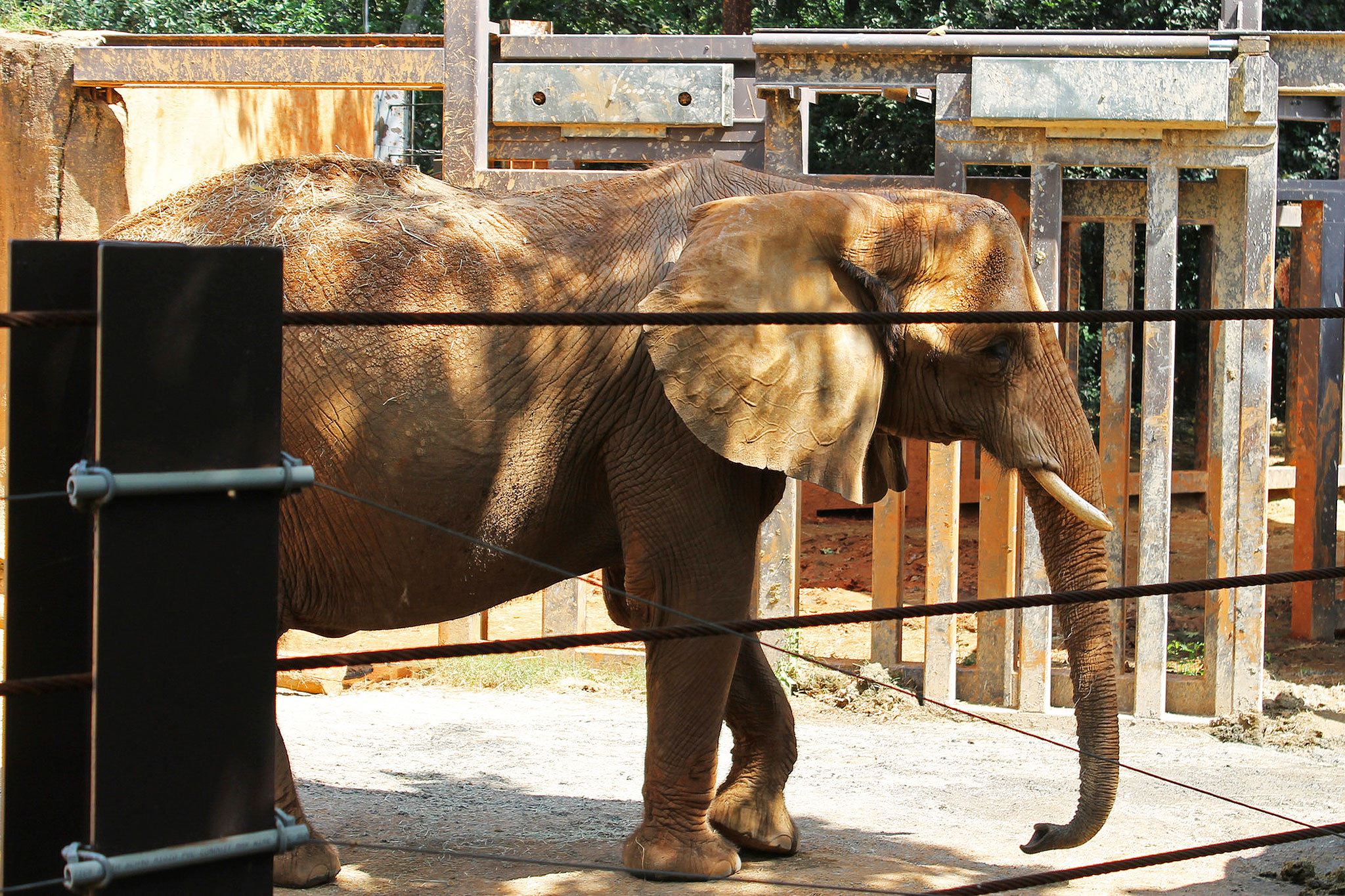
CREDIT: Larkyn T., Flickr
When two elephants die within six months of each other, it's time to think about a change. Petunia was euthanized at age 44 in December of 2016, after she was found in her exhibit unable to stand. The results of her necropsy revealed severe arthritis in her knees and left hip – a condition likely so painful she was unable to rise on her own. Lack of movement in small exhibits and standing on hard surfaces like concrete causes chronic and severe arthritis and often lethal foot infections in elephants. These conditions are the leading reasons for euthanizing elephants incarcerated in zoos.
Inadequate conditions in zoos artificially shorten elephants' lifespans by inducing problems normally associated with old age, such as arthritis, in elephants who should be in the prime of their lives. Had Petunia been living in the wild, she would still be reproducing and caring for her offspring. When a captive elephant dies, these problems are often wrongly attributed to age, rather than the chronic deterioration caused by years of captivity that slowly and silently kills elephants, while tickets continue to be sold.
A second elephant, 37-year old Penny, died at the zoo in May 2017, just six months after Petunia. The results of her necropsy are so far inconclusive, but she died far too young.
With only two elephants, Belle and Robin, remaining in a too-small exhibit, Riverbanks will have to bring in another elephant to meet the three-elephant minimum required under the Association of Zoos and Aquariums (AZA) elephant standards. Now is the opportune time for Riverbanks to send its two remaining elephants to an accredited sanctuary and close its antiquated elephant exhibit for good.
Dishonorable Mention - Repeat Offender
Edmonton Valley Zoo, Alberta, Canada
Between a Stone-Cold Rock and a Hard Place
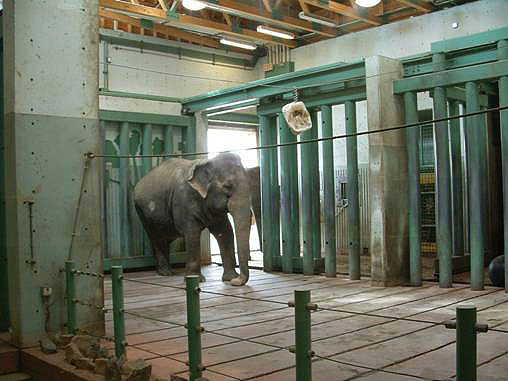
CREDIT: SAVELUCY.ca
If there's one entry on our list that just won't go away, it's Edmonton Valley Zoo. Here, poor Lucy, an Asian elephant, lives a lonely life of solitary confinement in a bone-chilling prison in one of the coldest cities in Canada. Lucy still suffers from health problems, which most - if not all - could be ameliorated with transfer to a warm-weather elephant sanctuary.
In 2016, Zoocheck and Voice For Animals launched a legal challenge to the issuance of the Edmonton Valley Zoo's annual provincial zoo permit requiring that the zoo comply with Alberta Zoo Standards. The action was aimed at achieving compliance with regional Zoo Standards, thereby resulting in the relief of Lucy's distress, ensuring a safer environment for her, as well as for visitors to the zoo.
Sadly, lawyers representing the Province of Alberta and the City of Edmonton argued that the animal welfare section of the Zoo Standards has no effect in law and is therefore unenforceable. And the presiding judge said that Alberta's Ministries of Agriculture and Forestry, and Environment and Parks, are not responsible for ensuring that the zoo is in compliance with the standards before issuing the annual zoo permit. Zoocheck and Voice for Animals are currently appealing that decision. In the meantime, Lucy's fate hangs in the balance while there appears to be no accountability for her welfare. Will someone in charge please stand up?!
Dishonorable Mention - Repeat Offender
Bronx Zoo, Bronx, New York
Has Anyone Seen Happy?
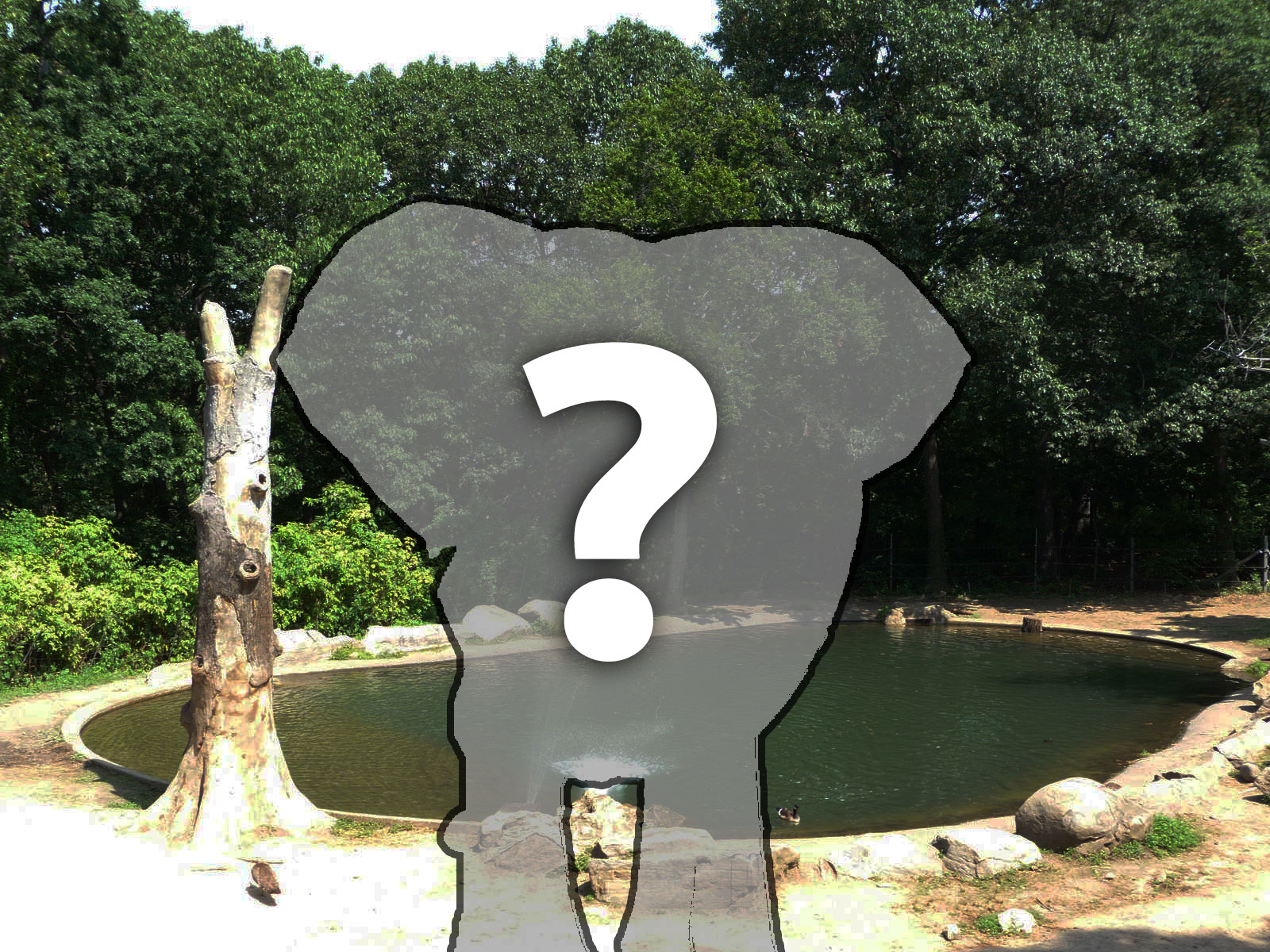
Visitors to the Bronx Zoo see the elephants from a monorail. Most likely, they will only see two of the three Asian elephants. The third elephant, ironically named Happy, has been isolated from the other two for roughly a decade. The social isolation and deprivation of poor Happy has earned this zoo a place on the Ten Worst Zoos List for the seventh year.
Why were the only photos of the elephants we've seen at this zoo in 2017 of Patty and Maxine? Where is the third, and loneliest elephant, Happy?
When we called the Bronx Zoo to inquire about the elephants, we were at first told there was only one elephant at the zoo, Happy. Upon further inquiry we were directed to the education department where we were informed it was "believed" there were two elephants at this zoo but that there was no one (yes, "NO ONE") who could tell us how many elephants the zoo has. We were informed, "Probably the person who cares for the elephants would know how many there are." We would certainly hope so, especially since they are certainly big enough to count! We did not receive a return call from the manager of the Bronx Zoo's educational department. The Bronx Zoo is clearly struggling with even the most basic of its "education" efforts.
Bronx Zoo has already been given a Dishonorable Mention on the Ten Worst Zoos List. This year it is here yet again, for dishonoring the most fundamental need of elephants: to be with other elephants. And for keeping the public, if not Happy herself, in the dark.

